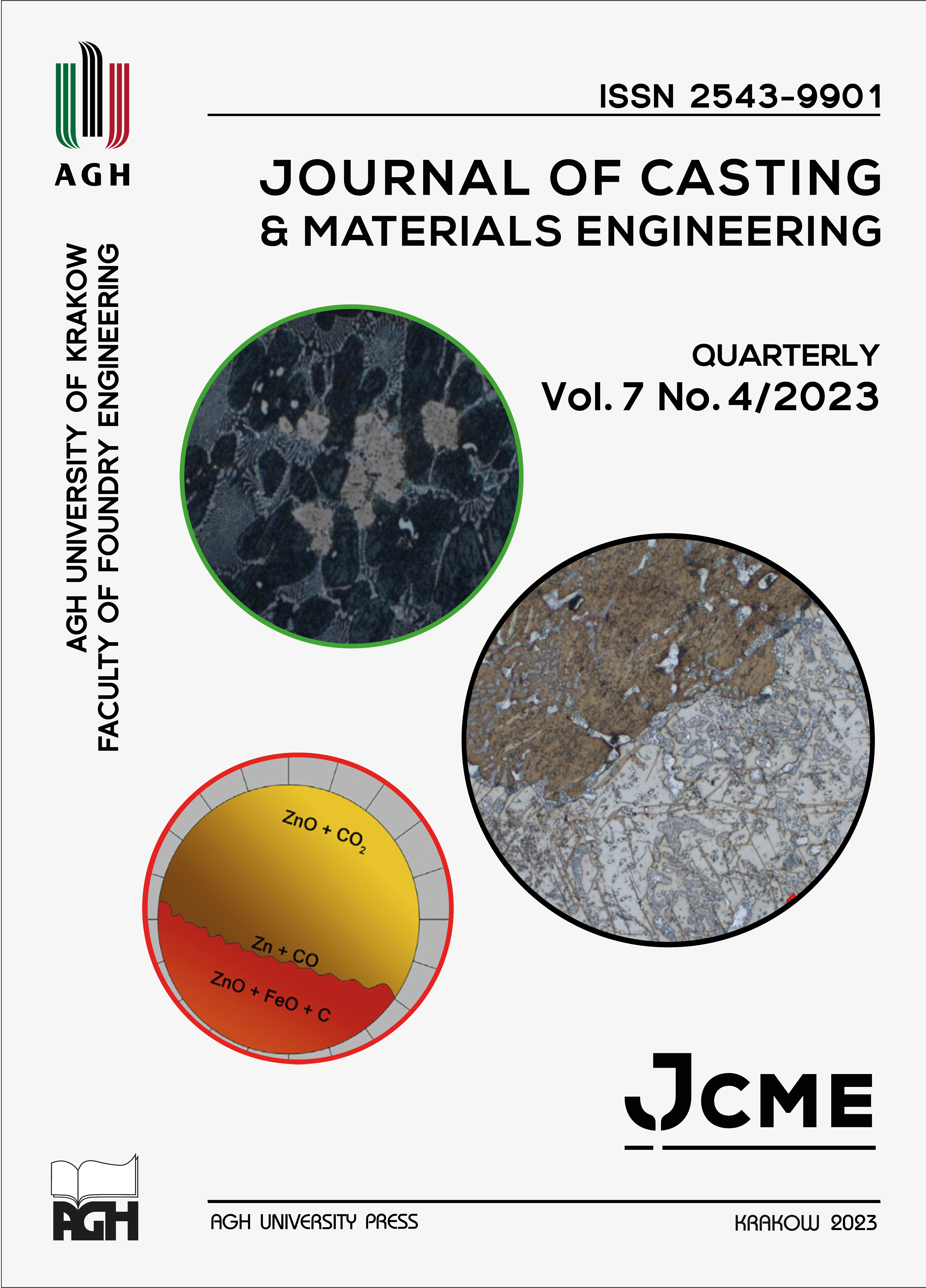The Circular Economy in Terms of Zinc Recovery from Industrial Waste – Directions for the Development and Profitability of Recycling
DOI:
https://doi.org/10.7494/jcme.2023.7.4.49Abstract
The article reviews the current state of the art in the field of zinc recycling. The results of model studies of the profitability (profitability) of the process of zinc recovery in precipitation in the form of dusts and sludges are presented. The cost of purchasing waste and the necessary energy and material expenditures were taken into account. It has been shown that access to a cheap source of waste is essential for the profitability of the zinc recovery process.
Downloads
References
Antrekowitsch J., Steinlechner S., Unger A., Rösler G., Pichler C. & Rumpold R. (2014). Zinc and Residue Recycling. In: Worrell E. & Reuter M.A. (Eds.), Handbook of Recycling. State-of-the-art for Practitioners, Analysts, and Scientists. Elsevier, 113–124. Doi: https://doi.org/10.1016/B978-0-12-396459-5.00009-X.
World Bureau of Metal Statistics 2001–2011. Retrieved form https://www.lseg.com/en/data-analytics/trading-solutions/world-bureau-metal-statistics [accessed: 23.03.2023].
Bureau of International Recycling (BIR) (2008). Report on the Environmental Benefits of Recycling. Retrieved from https://www.mgg-recycling.com/wp-content/uploads/2013/06/BIR_CO2_report.pdf [accessed: 23.03.2023].
Wernick I.K. & Themelis N.J. (1998). Recycling metals for the environment. Annual Review of Energy and the Environment, (23), 465–497. Doi: https://doi.org/10.1146/annurev.energy.23.1.465.
Stubbe G., Hillmann C. & Wolf C. (2016). Zinc and iron recovery from filter dust by melt bath injection into an induction furnace. World of Metallurgy – Erzmetall, 69(3), 161–168. Retrieved from https://www.velco.de/wp-content/uploads/2021/05/Erz-metall_Schmelzinjekt2016-1.pdf [accessed: 23.03.2023].
International Lead and Zinc Study Group (ILZSG): Statistics 2014 (www.ilzsg.org).
Ng K.S., Head I., Premier G.C., Scott K., Yu E., Lloyd J. & Sadhukhan J. (2016). A multilevel sustainability analysis of zinc recovery from wastes. Resources, Conversion and Recycling (113), 88–105. Doi: https://doi.org/10.1016/j.resconrec.2016.05.013.
Jha M.K., Kumar V. & Singh R.J. (2001). Review of hydrometallurgical recovery of zinc from industrial wastes. Resources, Conservation and Recycling, 33(4), 1–22. Doi: https://doi.org/10.1016/S0921-3449(00)00095-1.
Matinde E., Simate G.S. & Ndlovu S. (2018). Mining and metallurgical wastes: a review of recycling and re-use practices. Journal of the Southern African Institute of Mining and Metallurgy, 118, 825–844. Retrieved from https://www.researchgate.net/publication/324602638 [accessed: 23.03.2023].
European Commission (2015). Closing the Loop: An EU action plan for Circular Economy. COM 614/2. European Commission, Brussels. Retrieved from http://eurlex.europa.eu/resource.html?uri=cellar:8a8ef5e8-99a0-11e5-b3b7-01aa75ed71a1.0012.02/DOC_1&format=PDF [accessed: 24.11.2017].
Lottermoser B.G. (2011). Recycling, reuse and rehabilitation of mine wastes. Elements, (7)6, 405–410. Doi: https://doi.org/10.2113/gselements.7.6.405.
Wautelet T. (2018). Exploring the role of independent retailers in the circular economy: a case study approach [Master of Business Administration]. European University for Economics and Management, Luxembourg.
Circular economy: definition, importance and benefits. Retrieved from https://www.europarl.europa.eu/news/en/headlines/economy/20151201STO05603/circular-economy-definition-importance--and-benefits [accessed: 23.03.2023].
Koukkari P., Riihimäki T. & Ollonqvist P.-P. (2022). New Hydrometallurgical Treatment to Recover Zinc and Iron from EAF Dust. Word of Metallurgy – Erzmetall, 75(1), 1–8.
Raport o bezpieczeństwie dla ZGH „Bolesław” S.A. (2020). Retrieved from https://zghboleslaw.pl/images/pdf/2020/ZGHRoBstreszczenie21072020.pdf [accessed 23.03.2023].
Nejranowski A. (2022). Recykling pyłów i szlamów z procesów metalurgicznych w aspekcie technologicznym i ekonomicznym. Engineering thesis. AGH University of Krakow, Krakow.
Downloads
Published
Issue
Section
License
Copyright (c) 2023 Artur Bobrowski, Aleksander Nejranowski

This work is licensed under a Creative Commons Attribution 4.0 International License.


